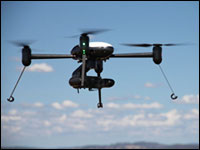
Remote-control vehicles once primarily inhabited the territory of hobbyists. People would take their planes out to a field on a Saturday afternoon and spin a few lazy circles in the sky.
With the advent of unmanned aerial vehicles, drones and other high-tech applications, however, it has quickly become a brave new remote-control world, where the lines between toys and surveillance equipment, hobbyists and professionals, are becoming increasingly blurred.
“I grew up building and flying model airplanes since I was 9 or 10 years old,” Zenon Dragan, president of UAV manufacturer Draganfly Innovations, told TechNewsWorld. “It turned into a hobby, and the hobby turned into a business.”
Quadcopter-Eye Views
Draganfly markets a variety of quadcopters, from toy models that sell for less than US$100 to high-end professional models that sell for tens of thousands. These can come equipped with cameras and other accessories, and they span from kids playing with toys to fire departments using them for search-and-rescue operations.
“Emergency services is the most promising industry, because they have a direct need,” said Dragan. “We’ve proven that it saves the government money — and it saves lives.”

These UAVs are easy to use — even for those with no model airplane or remote control experience, he emphasized.
“Back in the day, they were hard to fly and you would crash,” Dragan continued. “Now anyone can get really nice aerial photographs and video. Most of our customers have zero hobby experience. In two days training at our facility, they’re proficient at flying and capturing photos and videos.”
Those photos and videos can potentially be used by police departments, fire departments, wilderness search and rescue crews, journalists, and anyone else who wants to capture birds-eye views of events unfolding below without flying an actual manned craft.
While the FAA, other legal and regulatory agencies, and privacy advocates catch up in terms of the legality and ethics of such uses of unmanned vehicles, manufacturers like Dragan are already envisioning a future in which UAVs will be a prevalent part of everyday life.
“It’s going to spark a lot of creativity, with videos and pictures that people are going to take of interesting subjects that people weren’t able to do before,” predicted Dragan. “It’s going to be great for artists, videographers and photographers.”
UAV Education
States like Nevada — where UAV and drone research already has a strong military presence — are looking toward the future of these new technologies, designing and implementing test sites, educational programs, and new job pathways for graduates.
The FAA will soon be designating several sites across the U.S. to research potential commercial applications for UAVs, and Nevada officials hope that given its existing presence in this industry, its year-round sun, and its broad expanses of flat desert, their state will host one of these sites.
“The industry is transformative, and it stands to grow robustly,” Tom Wilczek, the defense and aerospace representative within the Nevada governor’s office of economic development, told TechNewsWorld. “Our governor is very supportive [of Nevada as a test site], the legislature is supportive, our delegates are supportive, and our community is supportive.”
The University of Nevada at Las Vegas and Reno, as well as the U of N’s Desert Research Institute, are in the process of examining potential courses and programs to help train those who want to work in the UAV industry.
“We’re starting by evaluating our existing programs,” Thomas Piechotainterim vice president for research at the University of Nevada, Las Vegas, told TechNewsWorld. “We have existing programs that support the UAV efforts, such as mechanical engineering, electrical engineering, and aerospace engineering. We want to better understand where we need to go with those programs, and whether there are new ones we need to develop.”
The transition from the sphere of hobbyists to the realm of military and industrial uses is something Piechota has noticed happening quickly on the desert fields of his state.
That transition began with the introduction of cameras, infrared devices, and other sensors onto the UAVs, he said.
“Hobbyists were flying them for the sake of flying them, but now when you add a sensor to them it takes on a whole different life,” said Piechota.
On the Ground
Though UAVs have gotten much attention of late, unmanned ground vehicles and unmanned surface vehicles are also seeing new uses, particularly when it comes to surveillance applications.
The Spynel-S, for instance, is a medium wavelength infrared cooled thermal camera coupled with intrusion detection and tracking software. It can detect objects, movement, and threats both on land and in maritime environments, and HGH Infrared Systems, its manufacturer, is currently working on fitting it on a variety of unmanned ground and surface vehicles.
“It unburdens cognitively the operator and provides reliable, quick actionable intelligence,” Vanessa Couturier, general manager for North American with HGH Infrared Systems, told TechNewsWorld.
“Without the ability to distinguish real threats from false alarms on a radar screen, the operators relying on a traditional tandem radar/PTZ were impaired by the ‘soda straw’ and had to shift the camera left and right in search of potential real targets. With the Spynel-S, the operator can immediately detect and visualize an unlimited number of threats in all directions at the same time.”
The Spynel-S, mounted on an unmanned vehicle, is able to perform wide-area surveillance in a variety of military, civilian and commercial applications.
“Our panoramic sensors have been deployed for Forward Operating Bases protection in Afghanistan, for night perimeter security in airports, or for antipiracy and narco-traffic operations in ports where the capability to spot fast boats, low-profile boats, swimmers and UAVs is paramount,” said Couturier.
“Radars typically have a hard time with this type of detection,” she noted. “A major application we see for the Spynel-S will be at the Southern border of the United States. Its versatility makes it a great surveillance device for wide desert areas in Arizona or bushy landscapes in the Rio Grande Valley.”





















































